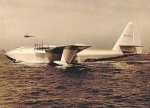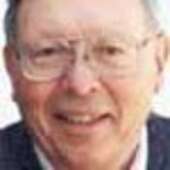Opinion
Howard Hughes, man of mystery
Monday, April 13, 2009

Hughes' flying boat, "The Spruce Goose."
One of the most famous, most interesting, and most controversial figures of the middle years of the last century would have to be -- Howard Hughes. According to author, Stan Lee, "He was an inventor, an aviation pioneer, an adventurer, a multi-billionaire, a ladies man, and finally, a first class nut case."
Howard Robard Hughes was born on Christmas Eve, 1905 in Houston, Texas, the only son of Howard Robard Hughes Sr., the founder of the Hughes Tool Company. The elder Hughes had invented a unique drilling tool for the oil industry, which proved to be the foundation for the family's huge fortune. When both his parents died before he was 18, the tool company became the property of Howard Jr. This allowed young Hughes to pursue multiple careers and a way of life restricted to very few.
Howard was an indifferent student, though from an early age he showed an aptitude for math and engineering. At age 11 he erected Houston's first wireless broadcasting system. He built the city's first motorized bicycle, using parts from his father's steam engine. At age 14 he began flying airplanes. Though he never did graduate from high school he took engineering classes at Cal Tech.

A dashing, young Howard Hughes
In 1925, after the death of both parents, with first wife, Ella, Hughes departed for California, where an uncle introduced him to the movie business. He was mesmerized by the movies and the people connected with the business, especially the starlets. Hughes is credited with making a number of the most important pictures of the day, from the 20s to the 50s, including Two Arabian Knights, Hell's Angels, Scarface, Front Page and Outlaw. Hughes films tended to break new ground in Hollywood. Hell's Angels, a flying film, costing at the time a record $3.1 million to produce in 1930, opened the way for more realism for air combat in films. The Outlaw featured bosomy Jane Russell and stretched the boundaries of film undress in Miss Russell's costumes. In that film Hughes used his engineering abilities to design a special bra for Miss Russell.
Following his divorce from first wife, Ella in 1929, Hughes developed his reputation as a womanizer, by dating some of Hollywood's most prominent actresses, including Bette Davis, Ava Gardner, Olivia de Haviland, Joan Fontaine and Katherine Hepburn, among others. For some years Hughes was one America's most eligible (and visible) bachelors. In 1957, before Hughes' eccentric behavior kicked in and he became a recluse, he married the popular actress, Jean Peters. The couple divorced in 1971.
Flying was and remained a passion of Howard Hughes for most of his lifetime. In California he learned the intricacies of flying from some of the pioneers of flying, and in the early 30s he established Hughes Aircraft. An early Hughes designed plane was the H-1 Hughes Racer, which established a speed record of 352 mph in 1935, and influenced the design of World War II fighters, including the Japanese Zero and German Focke-Wulf. In 1937, using a redesigned H-1 Racer, Hughes set the U.S. trans-continental record of 7 hours 28 minutes, or more than 322 mph average.
In 1938 Hughes captured the imagination of the world when he set a "round the world" flying record of 3 days 19 hours (91 hrs.). Flying a Lockeed Super-Electra plane, he started in New York City, continued on to Paris, Moscow, Omsk, Anchorage, Minneapolis, and back to NYC. He beat the old record by some four days.
In 1942, during World War II, the U.S. government contracted with Hughes to build a large transport plane, out of non-strategic materials, to ferry troops to Europe so as to avoid the German subs, which were menacing US transport ships in the Atlantic.
The plane, which Hughes designed, and delivered to the government in 1947, a year after the war had ended, was the famous H-4 Hughes Hercules, more commonly known as "The Spruce Goose." At the time it was the largest plane ever built--a behemoth flying boat, weighing some 190 tons, with a wingspan of 319 feet---19 feet longer than a football field! It was powered by 8 massive engines, with propellers 17' long. There was cargo space to carry two full sized box cars. It was built of wood (birch rather than spruce) as required, but it had never flown, and became the subject of a Senate Investigation. Hughes, himself, remedied that deficiency in 1947, during a break in the Senate hearings about the plane. With Hughes at the controls, engineers planned tests, just moving the plane on water, in the channel off Long Beach CA. Hughes, ever the eccentric, decided to take off and actually fly the plane. The flight was successful, if short. But it brought the Senate hearings to an abrupt termination, and Hughes was exonerated, albeit with a bit of a tarnished reputation.
In 1946 Hughes was involved in a near-fatal accident while flying an experimental plane for the Army. He was badly burned in the accident and suffered a number of broken bones. While recovering in the hospital he was dissatisfied with his hospital bed and proceeded to design a better one. He summoned Hughes engineers and instructed them to build a six-section bed with hot and cold running water. Push buttons activated 30 electric motors, which moved the bed in every conceivable direction.
Beginning in the late 40s, Hughes behavior became increasingly erratic. Once the most visible of celebrities, Hughes gradually withdrew from society, a victim of "Obsessive Compulsive Behavior". He was obsessed with avoiding germs to the point that he could no longer meet or touch people. He rarely went out in public.
He would go for months at a time just watching movies, often in the nude, eating nothing but chocolate and milk. (Reportedly, once during this time, he watched the movie "Ice Station Zebra" 150 times, one after another.) He would emerge from these sessions with long hair, and gruesomely long finger and toe nails.
During the last 10 years of his life, from 1966-1976 Hughes lived exclusively in luxury hotels, in a number of locations from Boston, to the Bahamas, to Mexico, and finally Las Vegas, where he took up residence in the penthouse of The Desert Inn. After some weeks the owner of The Desert Inn asked him to leave, as he had reserved the penthouse for another party. Hughes refused to leave, and to avoid trouble with the management, he bought The Desert Inn. Subsequently, he bought other Las Vegas hotels, Casinos, and TV stations, becoming the largest property owner in Las Vegas.
During this period Hughes decided that he could only trust men of the Mormon faith and surrounded himself with men who protected his privacy, handled his business affairs, and became known as "The Mormon Mafia". They also catered to his every whim. One time he became infatuated with Baskin-Robbin's "Banana Nut Ice Cream". Then Baskin-Robbins discontinued that flavor. Hughes insisted that they make a special batch just for him. The minimum special order was 350 gallons, which was ordered. No sooner had the order arrived, when Hughes decided he no longer cared for Banana-Nut Ice Cream. For most of the next year The Desert Inn served free Banana Nut Ice Cream to their hotel guests, till the 350 gallons were gone.
It is easy to dwell on Hughes' strange behavior in his latter years, but this would diminish his lifetime accomplishments, in aviation, the movies, and probably most of all, in medical technology, through the Hughes Medical Institute, one of the world's leaders in medical research. It is ironic that this wonderful institution of medical research was unable to help the man who made it all possible---Howard Hughes.
Source: Various internet sites

